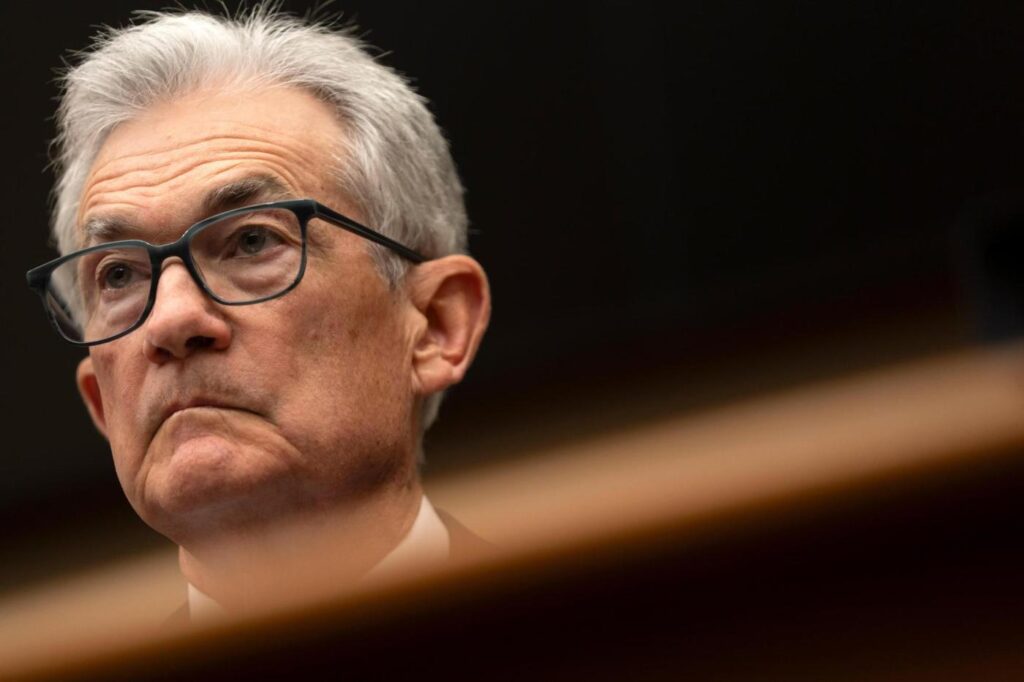
By Amara Omeokwe | Bloomberg
Jerome Powell will face pressure this week from lawmakers growing impatient for the Federal Reserve to cut interest rates and others who are unhappy with its latest plan to boost capital requirements for Wall Street lenders.
The Fed chair heads to Capitol Hill on Tuesday and Wednesday for his semiannual testimony, more than two years after he and his colleagues began hiking rates in a bid to curb surging inflation.
The hearings are Powell’s last scheduled public address to Congress ahead of the presidential election, and he’ll likely have to defend the central bank’s higher-for-longer policy stance as well as its claim to be independent of politics.
Fed officials in June pared back estimates of how many times they expect to lower borrowing costs this year, signaling they’ll hold rates at a two-decade high as they wait for more evidence inflation is headed down to their 2% target. Powell reiterated that message in comments last week, and declined to specify when rate cuts might begin.
Recent data indicate the Fed’s preferred inflation gauge slowed in May after a bumpy start to the year. A separate measure due Thursday is expected to show underlying inflation posted the smallest back-to-back monthly gains since August.
The labor market, however, is also cooling, and some Fed officials are beginning to warn about the risks of further slowing. June job gains, while still solid, were concentrated in health care and government, and prior months were revised lower. The unemployment rate climbed to 4.1%, the highest since late 2021.
Calls to cut
Democrats pressing for rate cuts say elevated borrowing costs are harming consumers already hit by high prices. As inflation remains top of mind for voters, the question of whether and when to cut rates is turning into a hot-button issue ahead of November’s presidential election.
At the Senate Banking Committee hearing on Tuesday, Senator Elizabeth Warren may press Powell for cuts, following the letter she and Democratic colleagues sent him last month demanding that the Fed follow the European Central Bank’s lead in easing monetary policy.
Other Democrats are walking a careful line to avoid accusations of meddling with the Fed’s independence, amid reports that former President Donald Trump could seek to curb the central bank’s power should he win another term.
Representative Jim Himes, who will hear from Powell on Wednesday before the House Financial Services Committee, said no member of Congress should ever pressure the Fed to raise or lower interest rates.
“One of the cornerstones of our stable economy is our independent monetary policy, and if we start doing electoral politics and monetary policy, the other side will, and soon we will not have a stable economy,” the Connecticut Democrat said.
Others say the calls to cut rates are based more on an assessment of the economy than politics.
“We are making an argument based on data and what we believe it shows,” said Representative Brendan Boyle. Despite the overall strength of the economy, “I think the worry about an economic slowdown is at this point greater than the worry that we haven’t gotten exactly down to 2.0%.”
The Pennsylvania Democrat also expressed concern that mortgage rates, which are nearly double pre-pandemic levels, are making homes unaffordable and keeping people who’d like to move from selling their homes.
That’s in line with some economists who argue the Fed is restraining growth unnecessarily.
“We’re within spitting distance of the target. All the trend lines look good,” said Mark Zandi, chief economist at Moody’s Analytics. He has called on the Fed to begin cutting rates immediately, in part because much of inflation’s stickiness above 2% is due to lagging measures of rents.
It could get increasingly complicated to cut rates as the election approaches, Zandi said: “Even though policymakers really don’t want to be influenced by the politics of the current time, they almost certainly are.”
Bank rules
Powell is also likely to face pointed questions over US plans to force Wall Street lenders to set aside significantly more capital. In March, the Fed chief said he expected “broad and material changes” to the proposal American regulators released last July that could require the eight largest US banks to hold about 19% more in capital as a cushion against financial shocks.
Republicans, including House Financial Services Committee Chairman Patrick McHenry, blasted the original plan. McHenry and other GOP lawmakers last September urged regulators withdraw the proposal, arguing that it had “fatal problems” and could pose a risk to the financial system.
Powell hasn’t said whether the central bank, Federal Deposit Insurance Corp. and the Office of the Comptroller of the Currency will scrap the original plan. However, Fed officials recently showed other US regulators a three-page document of possible changes to the planned overhaul that would significantly lighten the load on big lenders.
In a preview of what else could be in store for Powell on Tuesday, Sen. Warren recently accused him of giving bank executives too much opportunity to influence the proposal.
Powell has maintained the Fed doesn’t take politics into account when setting policy.
“I do think support for the Fed’s independence is very high where it really matters on Capitol Hill, in both political parties, among the leaders and most of the following,” Powell said last week. “And so I worry about getting the job right.”
Related Articles
The Federal Reserve’s war on inflation: How it works
206,000 jobs added in June, part of a softening that could bolster Fed rate cut
California’s economic anxieties at heights last seen in 2013
Walgreens will close ‘significant’ number of its 8,600 US locations
Home insurance at $10,000 a year shows California buyers’ pain
